You're using an outdated browser. Please upgrade to a modern browser for the best experience.
Please note this is a comparison between Version 2 by Bruce Ren and Version 1 by Moshe Gophen.
The Hula Valley in northern Israel was partly covered by swamps and a shallow lake. The entire valley was drained and converted for agricultural cultivation. Later, an additional soil reclamation operation was implemented, including eco-tourism. From the early 1990s, winter migratory cranes have attracted visitors, thus supporting the hydrological management of the entire valley that protects the downstream Lake Kinneret.
- cranes
- Hula Valley
- phosphorus
- pollution
Note: The following contents are extract from your paper. The entry will be online only after author check and submit it.
1. Introduction
1.1. The Kinneret Drainage Basin
The region that is geographically defined as the Hula Valley (altitude between 100 and 60 mbsl) has a surface area of about 200 km2 and provides about 7% of the watershed basin of Lake Kinneret [1] (Figure 1). The historic Hula wetland area within the valley generally refers to about 60 km2 of the entire valley [1,2,3][1][2][3]. The regional climate conditions are Mediterranean [1], with an annual winter rainfall of 350–850 mm, followed by a hot and dry summer. The temperature minima and maxima are, respectively, 18 and 35 °C in summer and 3 and 20 °C in winter [3,4][3][4]. The Hula Valley and the surrounding slopes are one of the most ancient human habitats [5], dating back to 73,000 BC.
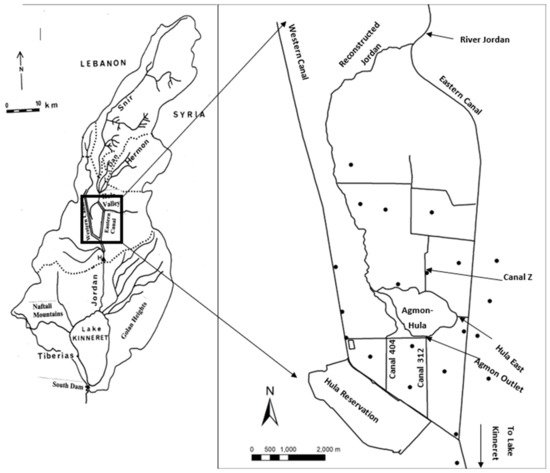
Figure 1. Geographical maps of the Lake Kinneret watershed with inflow rives (left) and the Hula Valley (right). Bore holes drills are indicated (black spots).
The Kinneret drainage basin (2730 km2, altitude range 2284–2260 mbsl) is located mostly to the north of the lake. Its maximum length from north to south is 110 km, and the width is 50 km [6]. During the past 80 years, the Lake Kinneret drainage basin ecosystem has undergone significant anthropogenic and natural modifications. Prior to the 1950s, the Hula Valley was mostly (6500 ha) covered with old Lake Hula (1300 ha) and swampy wetlands. This area was not cultivated, malaria was common, and water loss by evapo-transpiration (ET) was high. The Jordan River, which crosses the Hula Valley, contributes about 63% of the downstream Lake Kinneret’s water budget and 70% of the total nutrient inputs, of which over 50% originate from the Hula Valley region, including the valley and the slopes on both sides (east and west) of it. The old Lake Hula and its swamps were drained and converted for agricultural development. After the Hula drainage, the dominant N flux from the peat organic soil was modified from ammonium to nitrate. As a result of raw sewage removal and fishpond restrictions, the organic nitrogen flux into Lake Kinneret significantly reduced. As a result of inappropriate irrigation and agricultural methods, the peat soil quality deteriorated due to consolidation, destruction, and surface subsidence. This deterioration was accompanied by heavy dust storms [6] blocking drainage canals, due to peat organic soil dryness, resulting in deep cracks. This was followed by oxygen penetration, which accompanied exogenic decomposition of organic matter and heating, creating underground fires. The underground cracks, together with cultivated plant mater, immediately were populated by severe outbreaks of rodent populations. These deterioration processes caused severe damage to agricultural crops.
1.2. The Hula Reclamation Project
The Hula Reclamation Project (HRP) (Figure 1) was consequently implemented. The implementation of the HRP resulted in modifications to land use, which affected the regime of nutrient supply to Lake Kinneret. The HRP included the creation of a new shallow lake named Agmon (surface area 820 ha, mean depth 0.2 m, volume 0.164 × 106 m3) [7]; the renewal of 90 km drainage and water supply canals, placing a vertical plastic barrier of depth 4.5 m such that it spanned a distance of 2.8 km along the valley from east to west; maintenance of a higher underground water table; and functional conversion of 500 ha of the Hula Valley land, including Lake Agmon in the center, from agricultural to eco-tourism usage. The objectives of the HRP were (1) nutrient removal from the Lake Kinneret external loads through the Lake Agmon hydrological system; (2) production of an ecological component for eco-tourism, i.e., Lake Agmon; (3) usage of Lake Agmon as a principle component of hydrological management and agricultural irrigation for the entire valley; (4) improvement of irrigation water supply through portable computerized spray water lines; (5) maintenance of a high underground water table to enhance peat soil moisture and prevent peat soil quality deterioration; and (6) re-establishment of highly diverse natural flora and fauna, with emphasis on aquatic birds.
1.3. Cranes in the Hula Valley
In the early 1990s, peanut cultivation became attractive due to its high beneficial value and productive success as a result of the suitability of the peat organic soil. The winter migrators, cranes (Grus grus), on their long-term southern traditional migration to Africa, discovered some leftover peanuts after harvest [8,9][8][9]. Thus, the flocks massively landed in October–November in the Hula Valley. The population of cranes in the Hula Valley therefore increased. Unfortunately, when the rains came, the wet peanuts started to ferment and became less attractive to the cranes, resulting in their looking for other food sources, thereby causing damage to agricultural crops. At this point, a conflict arose: on the one hand, cranes attracted bird watchers (eco-tourism), but on the other hand, crop damage became common, where significant water supply enhanced agricultural development, which was damaged by the birds [10,11][10][11]. The rationale behind the Hula Reclamation Project was the protection of the Lake Kinneret water quality, combined with the production of beneficial (income source) crops for the citizens of northern Israel. The advantages of the Hula Reclamation Project included additional water allocation and improvement of the canal and irrigation systems (portable computerized spray lines) to improve crops, as well as development of eco-tourism where the soil was unsuitable for agriculture [7,12][7][12]. The increase in the crane population resulted in damaging these benefits.
2. Discussion
There is a difference between nitrogen and phosphorus dynamics in Lake Agmon. The lake is a nitrogen sink. Nevertheless, previous studies have confirmed partial removal of nitrogen from the Lake Agmon waters through denitrification and sedimentation. The continuity of a positive TPbalance indicates supplemental TP resources other than peat soil drainage, possibly crane droppings and re-suspension and/or submerged macrophytes. Local daily migration of cranes in the Hula Valley indicates terrestrial allocation during the daytime and in the Lake Agmon shallows at night while excretion of their droppings into the water. A quantitative monitoring of the seasonality of above and sub-surface aquatic vegetation was carried out during 1997–2004 [27][13]. The submerged vegetation onset started in April and peaked through July–August, followed by offset with dieback disappearance in December. During winter time (December through April), the aquatic plant biomass is negligible. Results indicate an average dry weight biomass of 456.4 tons (min.-max. −140–817) contained 0.9 tons of TP (max.–min. −0.3–1.2) and 7.4 tons of TN (max.-min. −2.7–10.5). The supplemental TP and TN loads to Lake Agmon through aquatic vegetation as related to soil drainage input were 10% and 8%, respectively. Lake Agmon was constructed during 1993 and filled with water in the summer of 1994. The ecological stability during the first years was partly flexible, and the Lake Agmon ecosystem was not yet stable. Therefore, nutrient mass balances were changed widely. For example, during the early 2000s, when the crane population was below 20,000, the TN and TP mass balance differed from the later period of 2008–2018. The TP balance prior to the crane migration was positive, and four years later, it was negative; therefore a significant contribution of TP by cranes is not suggested. Long-term records (1995–2018) indicate average (high range of SD) TN and TP concentrations in the Lake Agmon outflow of 4.67 and 0.17 ppm, respectively. Although the total mass removal of nutrients through the Lake Agmon system is not high, how much is affected by crane migration was not primarily predicted. Nevertheless, the seasonality of vegetation growth and consequent nutrient loads was also unpredictible. The ecological significance of a newly constructed system, such as the Hula Reclamation Project, accompanied by crane migration initiated the present study. The winter migratory cranes, which are fed supplementally by tons of corn seeds, are an essential source of phosphorus for the Lake Kinneret ecosystem. The four-month winter visit of cranes might therefore lead to lake pollution by phosphorus. The dynamics of water-mediated phosphorus input into Lake Kinneret is driven by the hydrological runoff and subterranean linkage between the Hula Valley and Lake Kinneret. Until the early 1990s, cranes were almost absent in the Hula Valley, excluding a few individuals. Since then, the valley has been populated annually from November through March by increasing numbers of cranes, up to 50,000 in the winter of 2019–2020 [8]. Leftover harvested peanuts attract the cranes in October–November. Peanut crops have been found to yield significantly high revenues and are suitable to be grown on the heavy-organic peat soil in the Hula Valley. In early to mid-December, the cranes start looking for other sources of food, thereby causing damage to winter crops. An efficient method aimed at prevention of agricultural damage has been improvised: Money is allocated as rental for a 40 ha field block in the valley, which serves as a feeding station for the cranes; here, corn seeds are purchased and fed to the cranes twice a day. Feeding starts in late December and continues until early March, when the cranes fly back to Europe for breeding [8]. This has proved to be efficient, but it has a costly disadvantage, since there is the tendency of phosphorus leakage into Lake Kinneret. This paper aims at suggesting ways of removal of the pollution parameter but also leaves room for further consideration of the unresolved issue of the financial cover source for the corn seed purchase. A brief search of the literature about phosphorus metabolism of birds indicates a wide range of its excretion [30,31][14][15] Although cranes are not typical water fowls due to their day–night stay discrimination between terrestrial and aquatic habitats, they are not the only Lake Agmon inhabitants. Among other inhabitants are ducks, herons, pelicans, cormorants, mallards, and seagulls [32][16]. Big flocks of migratory birds, such as cormorants, pelicans, seagulls, and mallards, are distributed among northern water bodies (fishponds, reservoirs, Lake Kinneret, temporal ponds, regional rivers), whilst the cranes create huge flocks located in the Hula Valley and presently (>2004) assembled in Lake Agmon during nighttime. Pelicans create big flocks but stay for a short period (2–3 weeks) partly on terrestrial land and partly in Lake Agmon. Cormorants are scattered in singles and locally migrate to Lake Kinneret. Conclusively, cranes are the major group to be defined as potential TP contributors to Lake Agmon input loads. The following data about phosphorus excretion by fowls were considered: Mallard platyrinchos and Larus ridibundum, 1–0.1 gP/bird/day [30][14]; cultured poultry broilers, 0.2–0.3 gP/bird/day [31][15]; and different migratory water fowls, 5.24 gP/bird/day (cranes and pelicans) and 3.5 gP/bird/day (cormorants) [33,34,35,36,37][17][18][19][20][21]. For the maximal effective value, the P excretion of cranes at 5.24 gP/bird/day was considered. Considering the presence of 50 × 103 cranes for 150 days (November through March) with 100% influx of their droppings into Lake Agmon waters, the annual P load from the birds would be (5.24 g) × (50,000 birds) × (150 days), which is equivalent to 39.3 tons. This is doubtless a significant extra load, which is almost 45% of the total measured annual input into Lake Kinneret from the River Jordan discharge. Nevertheless, this additional P load is not confirmed to be an extra loading to Lake Kinneret and likely also not a source of P to Lake Agmon. However, it was confirmed that this excreted P accumulates in the peat soil within the Hula Valley [15,38,39,40,41,42][22][23][24][25][26][27]. It is likely that P accumulation in the uppermost peat soil layer is probably not unlimited, and P migrates into the shallow subterranean groundwater table and most probably even much deeper. The role of migratory water fowls as nutrient vectors in managed wetlands was documented by Post et al. [43][28]. However, cranes as P vectors of corn seed P mediated into Lake Agmon and further on into Lake Kinneret were not confirmed. The conflict between cranes and agriculture is well known and highly documented [8]. Cranes are protected by international laws; shooting them is illegal, and thus deportation should be done without shooting. A collaborative solution between farmers, nature authorities, water managers, landowners, and regional municipalities was contracted and implemented. Cranes that land prior to mid-December are deported without shooting, with the aim to reduce the number of potential feeders, thereby preventing damage and reducing the cost of corn seeds. Corn seed feeding starts in mid-December. Cranes are not nocturnal, and their diurnal behavior includes feeding during the day; then they spend the full-darkness period (about 12–14 h) in Lake Agmon. The daily schedule of the cranes comprises 10–12 terrestrial day hours and a 12–14-h night period in Lake Agmon. Their noisy and remarkable local migration is aimed at reducing their vulnerability to predators. It is likely that most of the crane excretion takes place in the Lake Agmon waters at night. Studies carried out on migratory birds documented an increase in daily foraging activity with daytime (light time) prolongation, and the opposite is reasonable because daytime activity levels depend on light conditions (sun elevation) [44][29]. Moreover, Haynes et al. [45][30] documented intensive night activity of foraging and copulation by many species of water (wetland) birds, such as gulls (Laridae). Kostecke et al. [46][31] documented nocturnal time activity budgets consisted of foraging (62%) and resting (20%). A greater percentage of time was devoted to foraging and aggression, and less was spent resting at night [46][31]. Therefore, searching for the TP migration rate through Lake Agmon effluents is justified. Moreover, since 1994, the routine sampling of the Lake Agmon outflow has been carried out on a weekly basis in the mornings. The relevance of these samples to the evaluation of the impact of crane excretion on Lake Kinneret inputs might be criticized because the nocturnal stay of the birds is terminated before routine sampling. To avoid a biased conclusion, a calculation of the residence time (RT = inflow/volume) in Lake Agmon was done: the mean (2008–2018) value of the Lake Agmon daily inflow was 25.2 × 103 m3, the Lake Agmon surface area is 82 ha, and the mean depth is 20 cm. Consequently, the Lake Agmon total volume is 164 × 103 m3 and RT = 6.5 days, confirming the minority of daily flushing out of excreted crane droppings with accumulative potential. A major part of TP content in the crane droppings is due to the daily ingestion of food (corn seeds) collected outside Lake Agmon and results from resuspension carried out by bird stepping. Mass balances for TP in Lake Agmon indicate a negative regime, i.e., outflow is higher than inflow loads. These results, together with the results presented in Figure 1, support the conclusion about other sources besides crane droppings of the summer increase in TP in the Lake Agmon effluent. Moreover, during the period of 1970–1993, before the crane era (CE), the mean TP concentration was 0.224 ppm, whilst later (1994–2018), during the CE, it was 0.126 ppm. Conclusively, an increase in the TP concentration in Lake Agmon due to the activities of cranes is not confirmed. The Hula Valley annual contribution of TP and TN through the hydrological system of Lake Agmon, after the implementation of the Hula Reclamation Project (1996–2008), confirms the following: 1.2 and 26 tons of TP and TN, respectively, were removed from the Lake Kinneret external loads, which comprised 1.7% and 2.4% of the total loads of TP and TN, respectively [3,7,12,25,26][3][7][12][32][33]. Long- and short-term geochemical research on phosphorus and nitrogen dynamics within the peat soil in the Hula Valley, as well as in drainage canals in the vicinity of Lake Agmon [15,38,39,40,41,42][22][23][24][25][26][27] and in the subterranean waters, indicated high TP and TN levels. Nevertheless, the composition and dynamics of these pollutants in the River Jordan waters was not positively related to the soil and underground flows from the geochemical findings.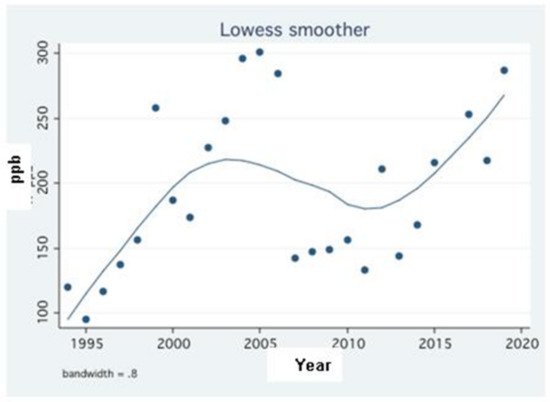
Figure 1. LOWESS smoother plot (bandwidth = 0.8) plot of the temporal (1994–2018) changes in annual averages of TP concentrations (ppb) in the Lake Agmon outflow.
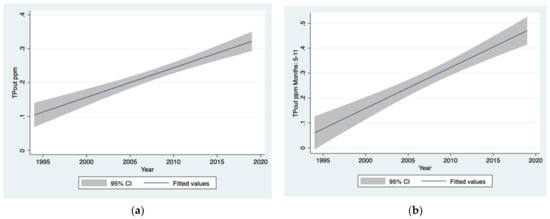
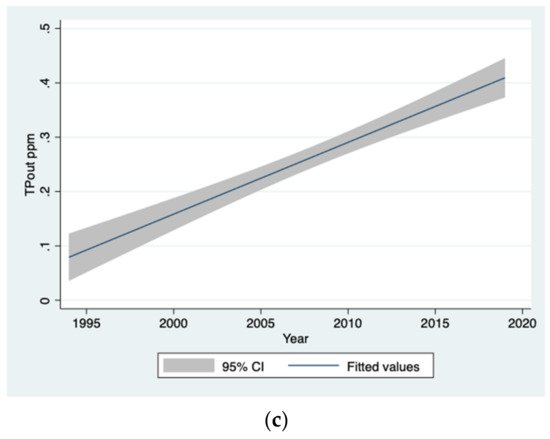
Figure 2. Linear regression (95% CI) between monthly means of TPout concentration (ppm) during crane months (12, 1, 2, 3, 4) (a) and no-crane months (5–11) (b) in 1994–2018. Linear regression (95% CI) between annual means of TPout concentrations (ppm) in (1994–2018) (c).
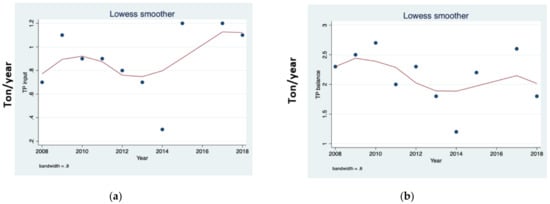
Figure 3. LOWESS smoother plot of trend in changes in annual loads (tons/year) of TPin (a) and TPbalance (b) during 2008–2018.
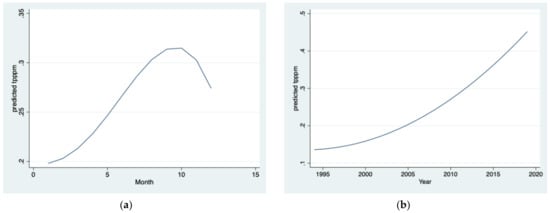
Figure 4. Fractional polynomial regression between monthly (a) and annual (b) means (1994–2018) of TPout concentrations (ppm).
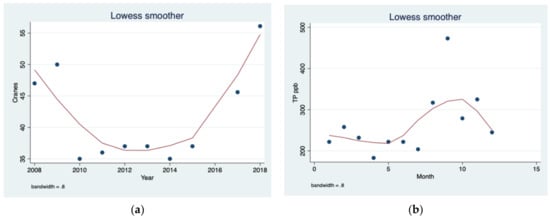
Figure 5. (a) Maximum cranes counted (103). (b) LOWESS smoother trend plot of changes in monthly means of TPout (ppb) during 1994–2018.

Figure 6. Fractional polynomial regression between monthly means (1994–2018) of TPout concentration (ppm) and no-crane months (5–11) (a) and crane months (12, 1, 2, 3, 4) (b).
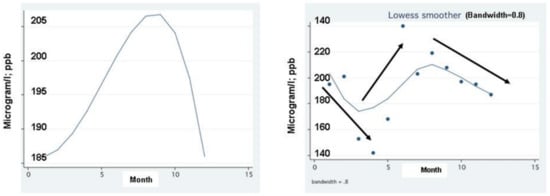
Figure 7. Monthly mean (1994–2018) fluctuations of TP concentrations (microgram/L; ppb) in the Lake Agmon outflow: Left: fractional polynomial regression. Right: LOWESS smoother plot (bandwidth = 0.8). Trends are arrowed.
-
Total fed (107 days) corn seeds—361 tons (cost 225,000 US$)
-
Total cost of crane deportation (6552.3 ha)—2 × 106 US$.
References
- Gophen, M. Water Utilization in Semi Arid Zone. Hula Valley (Israel): Pollutant removal, Agriculture and Ecotourism Management. In Water in the Middle East and North Africa: Resources, Protection, and Management; Springer: Berlin, Germany, 2003; pp. 207–225.
- Dimentman, C.; Bromley, H.J.; Por, F.D. Lake Hula: Reconstruction of the Fauna and Hydrobiology of a Lost Lake; The Israel Academy of Science and Humanities: Jerusalem, Israel, 1992; p. 170.
- Gophen, M.; Meron, M.; Orlov-Levin, V.; Tsipris, Y. Seasonal and spatial distribution of N & P substances in the Hula Valley (Israel) subterranean. Open J. Mod. Hydrol. 2014, 4, 121–131.
- Gophen, M. Climate Change—Enhanced, Cyanobacteria Domination in Lake Kinneret: A Retrospective Overview. Water 2021, 13, 163.
- Alperson-Afil, N.; Sharon, G.; Kislev, M.; Melamed, Y.; Zohar, I.; Ashkenazi, S.; Rabinovich, R.; Biton, R.; Werker, E.; Hartman, G.; et al. Spatial Organization of Hominin Activities at Gesher Benot Ya’aqov, Israel. Science 2009, 326, 1677–1680.
- Foner, A.H.; Ganor, E.; Gravenhorst, G. The Chemical composition and sources of the bulk deposition on Lake Kinneret (The Sea of Galilee), Israel. J. Arid. Environ. 2009, 73, 40–47.
- Gophen, M.; Meron, M.; Tsipris, Y.; Orlov-Levine, V.; Peres, M. Chemical, Hydrological and Climatological Properties of Lake Agmon, Hula Valley (Israel) (1994–2006). Open J. Mod. Hydrol. 2016, 6, 8–18.
- Alon, D.; Yom-Tov, Y. Cranes in the Hula Valley; Hula Project Annual Reports; Gophen, M., Ed.; 1999–2001; pp. 72–86. Available online: https://www.scirp.org/journal/paperinformation.aspx?paperid=75820 (accessed on 12 July 2021).
- Gophen, M. Partnerships between the Managements of Cranes (Grus grus) and Kinneret Water Quality Protection in the Hula Valley, Israel. Open J. Mod. Hydrol. 2017, 7, 200–208.
- Alonso, J.C.; Alonso, J.A.; Bautista, L.M. A review of the Crane-Agriculture Conflict at Gallocanta Lake, Spain. In Crane and Agriculture: A Global Guide for Sharing the Landscape; Austin, J.E., Morrison, K., Harris, J.T., Eds.; International Crane Foundation: Baraboo, WI, USA, 2018; pp. 271–279.
- Austin, J.E.; Morrison, K.L.; Harris, J.T. Cranes and Agriculture: A Global Guide for Sharing the Landscape. International Crane Foundation and IUCN Species Survival Commission Crane Specialist Group; The International Crane Foundation: Baraboo, WI, USA, 2018; p. 400.
- Gophen, M. Management Improvement of the Agmon Wetlands System (Hula Valley, Israel) aimed at Enhancement of Bird Populations and Kinneret Protection. Open J. Mod. Hydrol. 2015, 5, 1–9.
- Kaplan, D. 1997–2004 Chapter: Submerged Vegetation. In Hula Project Annual Reports; Gophen, M., Ed.; Jewish National Fund (KKL): Jerusalem, Israel, 1997–2005.
- Starmach, K. P excretion by Larus ridibundum and Malard platyrinchos. Ekol. Pol. 1996, 445, 289–297.
- Grana, A.L.; Tavernari, F.C.; Lelis, G.R.; Albino, L.F.T.; Rostagno, H.S.; Gomes, P.C. Evaluation of nutrient excretion and retention in broilers submitted to different nutritional strategies. Rev. Bras. Cien. Avic. 2013, 15, 1–13.
- Gophen, M. Water Utilization in Semi-Arid Zone, The Hula Valley (Israel): Pollutant Removal, Agriculture and Ecotourism Management. In Water in the Middle East and in North Africa, Resources, Protection, and Management; Zereini, F., Jaeschke, W., Eds.; Springer: Berlin/Heidelberg, Germany, 2004; pp. 207–225. Available online: https://www.researchgate.net/publication/301988613_Water_Utilization_in_Semi-Arid_Zone_The_Hula_Valley_Israel_Pollutant_Removal_Agriculture_and_Ecotourism_Management (accessed on 12 July 2021).
- Scherer, M.N.; Gibbons, H.L.K.; Stoops, B.; Muller, M. Phosphorus loading of an Urban Lake by Bird Droppings. Lake Reserv. Manag. 1995, 11, 317–327.
- Ganning, B.; Wulff, F. The effects of bird droppings on chemical and biological dynamics in brackish water rockpools. Oikos 1969, 20, 274–286.
- Sitters, S.E.; Bakker, J.M.B.; Veen, G.F.; Olde-Venternick, H.; Vanni, M. The stochiometry of nutrient release by terrestrial herbivore and its ecosystem consequences. Front. Earth Sci. 2017, 5, 32.
- Gould, D.J.; Fletcher, M.R. Gull droppings and their effects on water quality. Water Res. 1978, 12, 665–672.
- Fleming, P. The Impact of Waterfowl on Water Quality. Literature Review; Ridgetown College, University of Guelph: Ridgetown, ON, Canada, 2001; p. 14.
- Barnea, I. Reexamination of Phosphorus Fertilization Practices in the Altered Wetland Soil of Hula Valley, Israel. Ph.D. Thesis, The Hebrew University, Jerusalem, Israel, 2009.
- Haygarth, M.P.; Delgado, A.; Chardon, W.J.; Litaor, M.I.; Gil-Sotres, F.; Torrent, J. Phosphorus in soils and its transfer to water: From fine-scale soil processes to models and solutions in landscapes and catchments. Soil Use Manag. 2013, 29, 3–21.
- Litaor, M.I.; Chashmonai, I.; Barnea, I.; Reichmann, O.; Shenker, M. Assessment of phosphorus fertilizer practices in altered wetland soils using uncertainty analysis. Soil Use Manag. 2013, 29, 55–63.
- Litaor, M.I.; Reichmann, O.; Dente, E.; Naftaly, A.; Shenker, M. The impact of ornithogenic inputs on phosphorous transport from altered wetland soils to waterways in East Mediterranean ecosystem. Sci. Total Environ. 2014, 473, 36–42.
- Reichmann, O.; Chen, Y.; Litaor, M.I. Spatial Model Assessment of P Transport from Soils to Waterways in an Eastern Mediterranean Watershed. Water 2013, 5, 262–279.
- Reichman, O.; Chen, Y.; Litaor, M.I. The Impact of Rainfall-Runoff Events on the Water Quality of the Upper Catchment of the Jordan River, Israel. In Integrated Water Resources Management: Concept, Research and Implementation; Borchardt, D., Ed.; Springer: New York, NY, USA, 2016; pp. 129–146.
- Post, D.M.; Taylor, J.P.; Kitchell, J.F.; Olson, M.H.; Schindler, D.E.; Herwig, B.R. The Role of Migratory Waterfowl as Nutrient Vectors in a Managed Wetlands. Conserv. Biol. 1998, 12, 910–920.
- Pokrovski, I.; Kolzsch, A.; Sherub, S.; Feldler, W.; Glazov, P.; Kulikova, O.; Wikelski, M.; Flack, A. Longer days enable higher activity for migratory birds. J. Anim. Ecol. 2021.
- Hayes, F.E.; Hayward, J.L. Nocturnal copulation in Glaucous-winged Gulls Larus glaucescens. Mar. Ornithol. 2020, 48, 55–59.
- Kostecke, R.M.; Smith, L.M. Nocturnal behaviour of Amerucan Avocets in Playa Wetlands on the Sothern High Plains of Texas, USA. Waterbirds 2003, 26, 192–195.
- Gophen, M. Nutrient and plant dynamics in lake Agmon wetland (Hula Valley, Israel): A review with emphasis on Typha domingensis (1994–1999). Hydrobiologia 2000, 441, 25–36.
- Gophen, M. Nitrogen and Phosphorus dynamics in the Shallow Lake Agmon (Hula Valley, Israel). Open J. Ecol. 2015, 5, 55–65.
- Yatom, S.; Rabinovich, O. 1998 Hula Project Annual Report: Fractionation of organic soils in the Hula Valley. In Partition Indices and Organic Fractionation: Conclusive Report; Gophen, M., Ed.; Jewish National Fund (KKL): Jerusalem, Israel, 1999; pp. 86–99. (In Hebrew)
- Meron, S.M.Y.; Rabinovich, O.; Yasur, E.; Banin, A. Manganese Deficiency and Reduction of Organic Soil Productivity in the Hula Valley. In 1995 Hula Project Annual Report; Gophen, M., Ed.; Jewish National Fund (KKL): Jerusalem, Israel, 1996; pp. 8–21. (In Hebrew)
- Xiang, H.F.; Banin, A. Solid-Phase Manganese Fractionation Changes in Saturated Arid Zone Soil Pathways and Kinetics. Am. J. Soil Sci. 1996, 60, 1072–1080.
- Campbell, K.L.; Capece, J.C. Hydrologic Processes Influencing Phosphorus Transport. In Phosphorus Biogeochemistry in Subtropical Ecosystems; Reddy, R.K., O’Connor, G.A., Schelske, C.L., Eds.; LEWIS PUBLISHERS: Boca Raton, FL, USA; London, UK; New York, NY, USA; Washington, DC, USA, 1999; pp. 343–354.
- Gophen, M.; Kaplan, D.; Tsipris, Y.; Meron, M. The newly constructed wetland ecosystem of Lake Agmon (Hula Valley, Israel): Functional perspectives. In Treatment Wetlands for Water Quality Improvement, Quebec 2000 Conference Proceedings (Selected Papers); Pries, J., Ed.; CH2M Hill Canada Ltd.: North York, ON, Canada, 2001; pp. 53–62. Available online: https://www.migal.org.il/en/node/837/publications?title=&page=4 (accessed on 12 July 2021).
- Kaplan, D. Submerged Vegetation. In Hula Project Annual Report; Gophen, M., Ed.; Jewish National Fund (KKL): Jerusalem, Israel, 1998; pp. 85–96.
- Hambright, D.K.; Zohary, T. Lake Hula and Agmon: Destruction and creation of wetland ecosystem in northern Israel. Wetl. Ecol. Manag. 1998, 6, 83089.
More
